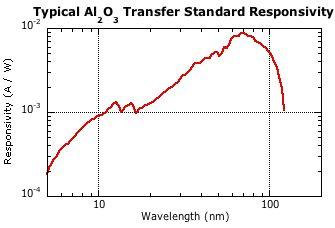Aluminum Oxide EUV Photodetector Transfer Standard

Aluminum oxide (Al2O3) photodiodes are issued by NIST as transfer standard detectors in the extreme ultraviolet spectral region (5 nm to 125 nm). Each device is a fused silica disk with a thin film (about 150 nm) of Al deposited. The native Al2O3 is grown in an anodizing bath to a thickness of about 15 nm. Once the photocathode is manufactured, it is mounted in a polytetrafluoroethylene (PTFE) body with a stainless steel cylindrical anode. Electrical connection is made to an aluminum back piece that provides both signal connection and a physical mounting point. Small screws secure the anode in place and provide electrical connection to the anode for the bias voltage. Incident radiation generates photoelectrons emitted from the Al2O3 surface which are detected as an electric current flowing from the back piece.
The responsivity of an Al2O3 photodetector is the externally detected electric current per unit of incident power. Typically, this is expressed in units of A / W. The responsivity peaks around 70 nm and falls as wavelength increases or decreases. The long-wavelength limit of response at around 125 nm corresponds to the work function of the oxide, approximately 10 eV. The responsivity falls to shorter wavelengths as the incident radiation becomes more penetrating and generates photoelectrons deeper in the material. These photoelectrons typically thermalize before they can be transported to the surface and emitted into the vacuum.
Al2O3 photodetectors have lower responsivity than silicon photodiodes, but exhibit much lower noise. These detectors are solar-blind, i.e. they do not respond to incident radiation in the near ultraviolet or visible wavelength range. They are also small and lightweight. While the Al2O3 photodetectors may respond without bias, especially at short wavelengths, they will be noisy and may be susceptible to small changes in local electric fields. They should be operated with the anode biased positive relative to the cathode, typically with a 60 V or 100 V, depending on the wavelength, potential difference.
Specifications/Capabilities
EUV Calibration Range: 5 nm to 125 nm
Typical Responsivity: 2x10–4 A / W to 1x10–2 A / W
Dynamic Range: 10 pW to 700 nW (wavelength dependent)
Active Area: 25 mm diameter
Scientific Opportunities/Applications
The Al2O3 transfer standard photodetectors are general-purpose radiometric detectors that respond to radiation in the extreme ultraviolet spectral region and are suitable for almost any application requiring the measurement of radiant power. These photodiodes are space-qualified and have significant flight heritage.

